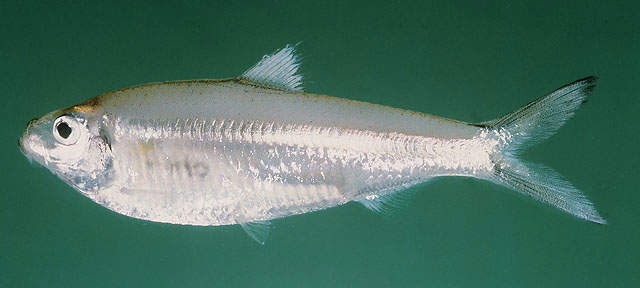| Dorosomatidae (Gizzard shads and sardinellas) |
| 10 cm SL (male/unsexed); max. reported age: 1 years |
|
pelagic-neritic; freshwater; brackish; marine; depth range 0 - 50 m, amphidromous |
| Indo-West Pacific: northern Indian Ocean (Karachi eastward to Rangoon) to Thailand, Indonesia (Java Sea), the Philippines, Papua New Guinea, and Australia. |
|
Dorsal spines (total): 0-0; Dorsal soft rays (total): 13-21; Anal spines: 0-0; Anal soft rays: 14-19. Belly strongly keeled. The almost rectangular second supra-maxilla and the bright silver stripe along the flank distinguish it from juveniles of Sardinella, Amblygaster and Herklotsichthys. Resembles some pellonulines with a silver stripe, but they lack a first supra-maxilla. Distinguished from E. elongata of the Gulf of Thailand but its deeper body and broader silver stripe. |
| Forms schools in shallow waters, the juveniles apparently entering the lower parts of rivers, but returning later to the sea. Feeds on both zooplankton (copepods, crab zoea, larvae of bivalves and fish eggs) and phytoplankton. Breeds from October to February (mainly November to January) off western coast of India, usually in relatively shallow inshore waters. Marketed fresh and dried-salted. |
|
Least Concern (LC); Date assessed: 28 February 2017 Ref. (130435)
|
| harmless |
Source and more info: www.fishbase.org. For personal, classroom, and other internal use only. Not for publication.
